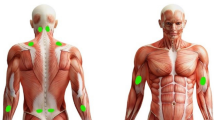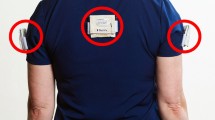Abstract
Background
Laparoscopic surgery requires the surgeon to assume atypical postures for extended periods of time, potentially leading to fatigue and chronic injury. This study assessed the level of muscle activity and compared the effects of fatigue, monitor placement, and surgical experience during simulated laparoscopic surgery.
Methods
Four attending and four resident surgeons repeated a series of four tasks with a Viewsite and a standard operating room monitor. Electromyography (EMG) activity and muscular discomfort scores were obtained before and after a “fatigue session.” Two variables, the EMG amplitudes and discomfort scores, were analyzed.
Results
The EMG amplitudes generally exceed the recommended threshold limits of acceptable muscular load. EMG data and discomfort scores demonstrated a fatigue response in several muscle groups. Minimal differences between the two monitor positions were seen. Overall, the EMG data and discomfort scores showed less muscle activity and discomfort in the attending surgeons.
Conclusion
Laparoscopic surgery required a relatively high muscular load, putting surgeons at risk for fatigue and injury. Altering the monitor placement did not reduce the surgeon’s risk of fatigue. Experience slightly reduced the level of fatigue, but not enough to reduce the surgeon’s risk category.
Similar content being viewed by others
References
Arndt R (1983) Working posture and musculoskeletal problems of video display terminal operators — review and reappraisal. Am Ind Hyg Assoc J 44: 431–446
Basmajian JV, DeLuca CJ (1985) Muscles alive their functions revealed by electromyography. Williams & Wilkins, Baltimore, MD
Berguer R (1998) Surgical technology and the ergonomics of laparoscopic instruments. Surg Endosc 12: 458–462
Berguer R, Remler M, Beckley D (1997) Laparoscopic instruments cause increased forearm fatigue: a subjective and objective comparison of open and laparoscopic techniques. Minimally Invasive Ther Allied Technol 36–40
Christensen H (1986) Muscle activity and fatigue in the shoulder muscles during repetitive work. An electromyographic study. Eur J Appl Physiol 54: 596–601
Cuschieri A (1995) Whither minimal access surgery: tribulations and expectations. Am J Surg 169: 9–19
Hammarskjold E, Harms-Ringdahl K (1992) Effect of arm-shoulder fatigue on carpenters at work. Eur J Appl Physiol 64: 402–409
Jensen BR, Schibye B, Sogaard K, Simonsen EB, Sjogaard G (1993) Shoulder muscle load and muscle fatigue among industrial sewing-machine operators. Eur J Appl Physiol 67: 467–475
Jonsson B (1978) Quantitative electromyographic evaluation of muscular load during work. Scand J Rehabil Med Suppl 6: 69–74
Kendall FP, McCreary EK, Provance PG (1993) Muscles testing and function. William & Wilkins, Baltimore, MD
Kvarnstrom S (1983) Occurrence of musculoskeletal disorders in a manufacturing industry with special attention to occupational shoulder disorders. Scand J Rehabil Med Suppl 8: 1–114
Mathiassen SE, Aminoff T (1997) Motor control and cardiovascular responses during isoelectric contractions of the upper trapezius muscle: evidence for individual adaptation strategies. Eur J Appl Physiol 76: 434–444
Milerad E, Ericson MO (1994) Effects of precision and force demands, grip diameter, and arm support during manual work: an electromyographic study. Ergonomics 37: 255–264
Milerad E, Ericson MO, Nisell R, Kilbom A (1991) An electromyographic study of dental work. Ergonomics 34: 953–962
Palmerud G, Kadefors R, Sporrong H, Jarvholm U, Herberts P, Hogfors C, Peterson B (1995) Voluntary redistribution of muscle activity in human shoulder muscles. Ergonomics 38: 806–815
Patkin M, Isabel L (1995) Ergonomics, engineering and surgery of endosurgical dissection. J R Coll Surg Edinburgh 40: 120–132
Underwood RA, Luttmann DR, Soper NJ, Halpin VJ, Shannon WD, Burguer R (2000) Musculoskeletal discomfort to performance of surgical procedures — development of a subjective discomfort [abstract]. Surg Endosc 14: S224
U.S. Department of Health and Human Services (DHHS) (1992) Selected topics in surface electromyography for use in the occupational setting: expert perspectives [pamphlet]. DHHS, Washington, DC.
Yang JF, Winter DA (1983) Electromyography reliability in maximal and submaximal isometric contractions. Arch Phys Med Rehab 64: 417–420
Author information
Authors and Affiliations
Rights and permissions
About this article
Cite this article
Uhrich, M.L., Underwood, R.A., Standeven, J.W. et al. Assessment of fatigue, monitor placement, and surgical experience during simulated laparoscopic surgery. Surg Endosc 16, 635–639 (2002). https://doi.org/10.1007/s00464-001-8151-5
Received:
Accepted:
Published:
Issue Date:
DOI: https://doi.org/10.1007/s00464-001-8151-5




